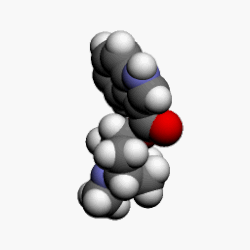 | |
 | |
| Clinical data | |
|---|---|
| Trade names | Navoban |
| Other names | ICS 205-930 |
| AHFS/Drugs.com | International Drug Names |
| Pregnancy category |
|
| Routes of administration | Oral, IV |
| ATC code | |
| Legal status | |
| Legal status | |
| Pharmacokinetic data | |
| Bioavailability | ~60–80% |
| Protein binding | 71% |
| Metabolism | Hepatic (CYP3A4, CYP1A2, CYP2D6) |
| Elimination half-life | 6–8 hours |
| Excretion | Renal, Fecal |
| Identifiers | |
| |
| CAS Number | |
| PubChem CID | |
| IUPHAR/BPS | |
| DrugBank | |
| ChemSpider | |
| UNII | |
| KEGG | |
| ChEBI | |
| ChEMBL | |
| CompTox Dashboard (EPA) | |
| Chemical and physical data | |
| Formula | C17H20N2O2 |
| Molar mass | 284.359 g·mol−1 |
| 3D model (JSmol) | |
| |
| |
| | |
Tropisetron is a serotonin 5-HT3 receptor antagonist used mainly as an antiemetic to treat nausea and vomiting following chemotherapy, although it has been used experimentally as an analgesic in cases of fibromyalgia.[1]
It was patented in 1982 and approved for medical use in 1992.[2] It is on the World Health Organization's List of Essential Medicines.[3] It is marketed by Novartis in Europe, Australia, New Zealand, Japan, South Korea and the Philippines as Navoban, but is not available in the U.S. It is also available from Novell Pharmaceutical Laboratories and marketed in several Asian countries as Setrovel.
- ^ Müller W, Stratz T (2004). "Local treatment of tendinopathies and myofascial pain syndromes with the 5-HT3 receptor antagonist tropisetron". Scandinavian Journal of Rheumatology. Supplement. 119 (119): 44–48. doi:10.1080/03009740410007032. PMID 15515413. S2CID 24916914.
- ^ Fischer J, Ganellin CR (2006). Analogue-based Drug Discovery. John Wiley & Sons. p. 448. ISBN 9783527607495.
- ^ World Health Organization (2021). World Health Organization model list of essential medicines: 22nd list (2021). Geneva: World Health Organization. hdl:10665/345533. WHO/MHP/HPS/EML/2021.02.